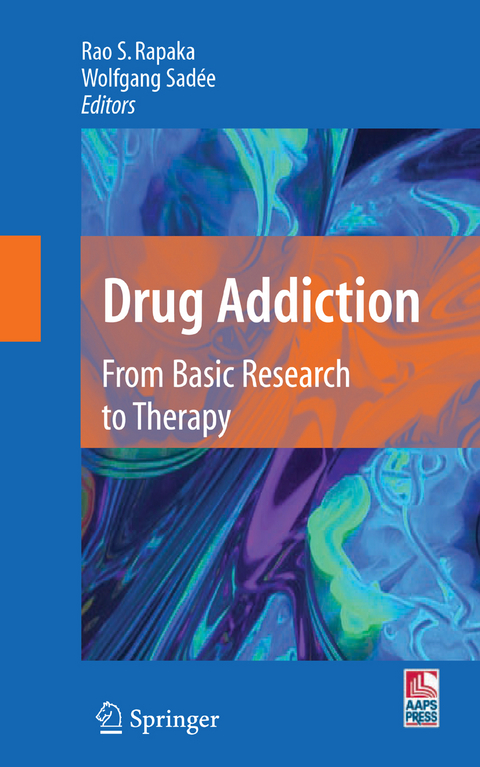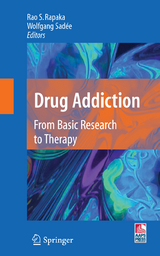Drug Addiction
Springer-Verlag New York Inc.
978-0-387-76677-5 (ISBN)
General Topics.- DARPP-32 Mediates the Actions of Multiple Drugs of Abuse.- Drug Discovery From Natural Sources.- Computational Methods in Drug Design: Modeling G Protein-Coupled Receptor Monomers, Dimers, and Oligomers.- Symbiotic Relationship of Pharmacogenetics and Drugs of Abuse.- Monoclonal Antibody Form and Function: Manufacturing the Right Antibodies for Treating Drug Abuse.- Cocaine- and Amphetamine-Regulated Transcript Peptides Play a Role in Drug Abuse and Are Potential Therapeutic Targets.- RNAi-Directed Inhibition of DC-SIGN by Dendritic Cells: Prospects for HIV-1 Therapy.- Viewing Chemokines as a Third Major System of Communication in the Brain.- Targeting the PDZ Domains of Molecular Scaffolds of Transmembrane Ion Channels.- Neuronal Nicotinic Acetylcholine Receptor Expression and Function on Nonneuronal Cells.- Transporters & Stimulants & Hallucinogens.- Role of Monoamine Transporters in Mediating Psychostimulant Effects.- Development of the Dopamine Transporter Selective RTI-336 as a Pharmacotherapy for Cocaine Abuse.- Serotonin Transporters: Implications for Antidepressant Drug Development.- Recent Advances for the Treatment of Cocaine Abuse: Central Nervous System Immunopharmacotherapy.- ? Opioids as Potential Treatments for Stimulant Dependence.- Regulation of Monoamine Transporters: Influence of Psychostimulants and Therapeutic Antidepressants.- Hallucinogen Actions on 5-HT Receptors Reveal Distinct Mechanisms of Activation and Signaling by G Protein-Coupled Receptors.- Recognition of Psychostimulants, Antidepressants, and Other Inhibitors of Synaptic Neurotransmitter Uptake by the Plasma Membrane Monoamine Transporters.- Dual Dopamine/Serotonin Releasers as Potential Medications for Stimulant and Alcohol Addictions.- Receptors of Mammalian TraceAmines.- Drug Design: Nicotine, Opioids and Related Ligands.- The Role of Crystallography in Drug Design.- Opioid Peptide-Derived Analgesics.- Opioid Ligands with Mixed ?/? Opioid Receptor Interactions: An Emerging Approach to Novel Analgesics.- Small-Molecule Agonists and Antagonists of the Opioid Receptor-Like Receptor (ORL1, NOP): Ligand-Based Analysis of Structural Factors Influencing Intrinsic Activity at NOP.- Kappa Opioid Antagonists: Past Successes and Future Prospects.- In Vitro and Direct In Vivo Testing of Mixture-Based Combinatorial Libraries for the Identification of Highly Active and Specific Opiate Ligands.- Current Status of Immunologic Approaches to Treating Tobacco Dependence: Vaccines and Nicotine-Specific Antibodies.- New Paradigms and Tools in Drug Design for Pain and Addiction.- Opioids: General.- Neuropeptide-Processing Enzymes: Applications for Drug Discovery.- CNS Drug Delivery: Opioid Peptides and the Blood-Brain Barrier.- Cell-Permeable, Mitochondrial-Targeted, Peptide Antioxidants.- Targeting Opioid Receptor Heterodimers: Strategies for Screening and Drug Development.- Homology Modeling of Opioid Receptor-Ligand Complexes Using Experimental Constraints.- Molecular Recognition of Opioid Receptor Ligands.- Role of Morphine’s Metabolites in Analgesia: Concepts and Controversies.- Mu Opioid Receptor Regulation and Opiate Responsiveness.- Agmatine: Biological Role and Therapeutic Potentials in Morphine Analgesia and Dependence.- Cannabinoid.- The Therapeutic Potential of Drugs that Target Cannabinoid Receptors or Modulate the Tissue Levels or Actions of Endocannabinoids.- Further Advances in the Synthesis of Endocannabinoid-Related Ligands.- Ajulemic Acid (IP-751): Synthesis, Proof of Principle, Toxicity Studies, and Clinical Trials.-Conformational Characteristics of the Interaction of SR141716A with the CB1 Cannabinoid Receptor as Determined Through the Use of Conformationally Constrained Analogs.- Activation of G-Proteins in Brain by Endogenous and Exogenous Cannabinoids.- 2-Arachidonoylglycerol (2-AG) Membrane Transport: History and Outlook.- Endocannabinoid Mechanisms of Pain Modulation.
| Erscheint lt. Verlag | 7.7.2008 |
|---|---|
| Zusatzinfo | 1 Illustrations, color; 196 Illustrations, black and white; XXIII, 782 p. 197 illus., 1 illus. in color. |
| Verlagsort | New York, NY |
| Sprache | englisch |
| Maße | 155 x 235 mm |
| Themenwelt | Medizin / Pharmazie ► Medizinische Fachgebiete ► Pharmakologie / Pharmakotherapie |
| Medizin / Pharmazie ► Medizinische Fachgebiete ► Suchtkrankheiten | |
| Medizin / Pharmazie ► Pharmazie | |
| ISBN-10 | 0-387-76677-4 / 0387766774 |
| ISBN-13 | 978-0-387-76677-5 / 9780387766775 |
| Zustand | Neuware |
| Informationen gemäß Produktsicherheitsverordnung (GPSR) | |
| Haben Sie eine Frage zum Produkt? |
aus dem Bereich




